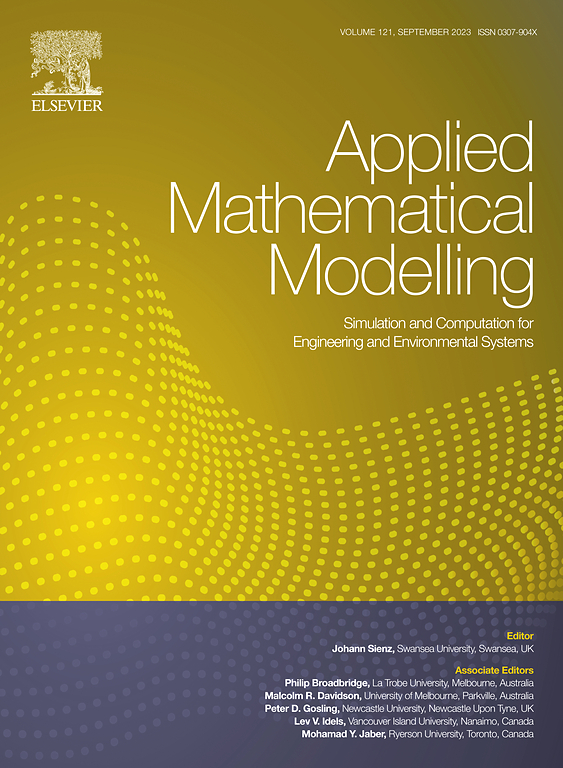- 充值
- 帮助

Applied Mathematical Modelling focuses on research related to the mathematical modelling of engineering and environmental processes, manufacturing, and industrial systems. A significant emerging area of research activity involves multiphysics processes, and contributions in this area are particularly encouraged. This influential publication covers a wide spectrum of subjects including heat transfer, fluid mechanics, CFD, and transport phenomena; solid mechanics and mechanics of metals; electromagnets and MHD; reliability modelling and system optimization; finite volume, finite element, and boundary element procedures; modelling of inventory, industrial, manufacturing and logistics systems for viable decision making; civil engineering systems and structures; mineral and energy resources; relevant software engineering issues associated with CAD and CAE; and materials and metallurgical engineering. Applied Mathematical Modelling is primarily interested in papers developing increased insights into real-world problems through novel mathematical modelling, novel applications or a combination of these. Papers employing existing numerical techniques must demonstrate sufficient novelty in the solution of practical problems. Papers on fuzzy logic in decision-making or purely financial mathematics are normally not considered. Research on fractional differential equations, bifurcation, and numerical methods needs to include practical examples. Population dynamics must solve realistic scenarios. Papers in the area of logistics and business modelling should demonstrate meaningful managerial insight. Submissions with no real-world application will not be considered. Also please visit Applied Mathematical Modelling’s Electronic service at: https://wwwcf.editorialmanager.com/AMMOD/default.aspx. Benefits to authors We also provide many author benefits, such as free PDFs, a liberal copyright policy, special discounts on Elsevier publications and much more. Please click here for more information on our author services. Please see our Guide for Authors for information on article submission. This journal has an Open Archive. All published items, including research articles, have unrestricted access and will remain permanently free to read and download 48 months after publication. All papers in the Archive are subject to Elsevier's user license.
- 主办单位: ELSEVIER SCIENCE INC
- 出版周期: 月刊
- 国际标准连续出版物号: ISSN 0307-904X
- 创刊时间: 1976年
-
vol.89 (2021)
vol.89 (2021)
Pt 2 Pt 1 P2 -
vol.77 (2020)
vol.77 (2020)
-
vol.40 (2016)
vol.40 (2016)
-
vol.39 (2016)
vol.39 (2016)
-
vol.40 (2015)
vol.40 (2015)
-
vol.39 (2015)
vol.39 (2015)
-
vol.40 (2014)
vol.40 (2014)
-
vol.39 (2014)
vol.39 (2014)
-
vol.38 (2014)
vol.38 (2014)
-
vol.40 (2013)
vol.40 (2013)
-
vol.39 (2013)
vol.39 (2013)
-
vol.38 (2013)
vol.38 (2013)
-
vol.37 (2013)
vol.37 (2013)
-
vol.39 (2012)
vol.39 (2012)
-
vol.36 (2012)
vol.36 (2012)
-
vol.39 (2011)
vol.39 (2011)
-
vol.36 (2011)
vol.36 (2011)
-
vol.35 (2011)
vol.35 (2011)
-
vol.34 (2010)
vol.34 (2010)
-
vol.34 (2009)
vol.34 (2009)
-
vol.33 (2009)
vol.33 (2009)
-
vol.32 (2008)
vol.32 (2008)
-
vol.33 (2007)
vol.33 (2007)
-
vol.31 (2007)
vol.31 (2007)
-
vol.32 (2006)
vol.32 (2006)
-
vol.30 (2006)
vol.30 (2006)
-
vol.31 (2005)
vol.31 (2005)
-
vol.30 (2005)
vol.30 (2005)
-
vol.29 (2005)
vol.29 (2005)
-
vol.29 (2004)
vol.29 (2004)
-
vol.28 (2004)
vol.28 (2004)
-
vol.28 (2003)
vol.28 (2003)
-
vol.27 (2003)
vol.27 (2003)
-
vol.26 (2002)
vol.26 (2002)
-
vol.25 (2001)
vol.25 (2001)
-
vol.25 (2000)
vol.25 (2000)
-
vol.24 (2000)
vol.24 (2000)
-
vol.23 (1999)
vol.23 (1999)
-
vol.22 (1998)
vol.22 (1998)
-
vol.21 (1997)
vol.21 (1997)
-
vol.20 (1996)
vol.20 (1996)
-
vol.19 (1995)
vol.19 (1995)
-
vol.19 (1994)
vol.19 (1994)
-
vol.18 (1994)
vol.18 (1994)
-
vol.17 (1993)
vol.17 (1993)
-
vol.19 (1992)
vol.19 (1992)
-
vol.16 (1992)
vol.16 (1992)
-
vol.15 (1991)
vol.15 (1991)
-
vol.14 (1990)
vol.14 (1990)
-
vol.13 (1989)
vol.13 (1989)
-
vol.12 (1988)
vol.12 (1988)
-
vol.11 (1987)
vol.11 (1987)
-
vol.10 (1986)
vol.10 (1986)
-
vol.9 (1985)
vol.9 (1985)
-
vol.8 (1984)
vol.8 (1984)
-
vol.7 (1983)
vol.7 (1983)
-
vol.6 (1982)
vol.6 (1982)
-
vol.5 (1981)
vol.5 (1981)
-
vol.4 (1980)
vol.4 (1980)
-
vol.3 (1979)
vol.3 (1979)
-
vol.2 (1978)
vol.2 (1978)
-
vol.1 (1977)
vol.1 (1977)
-
vol.1 (1976)
vol.1 (1976)
- 1
- 2
- 3
- 4
- 7

 分析评价
分析评价
